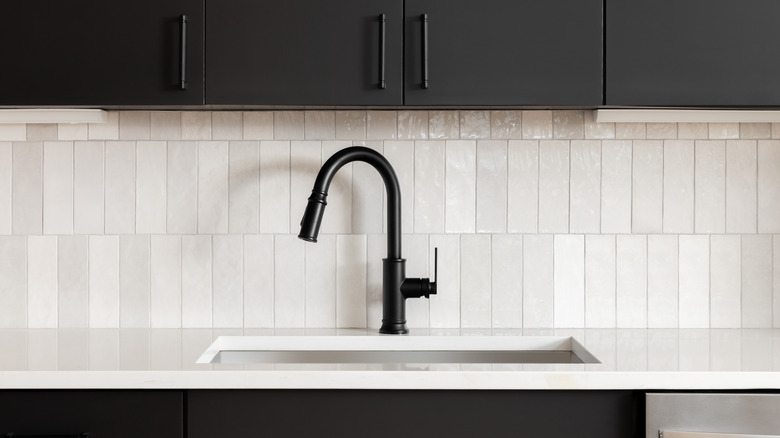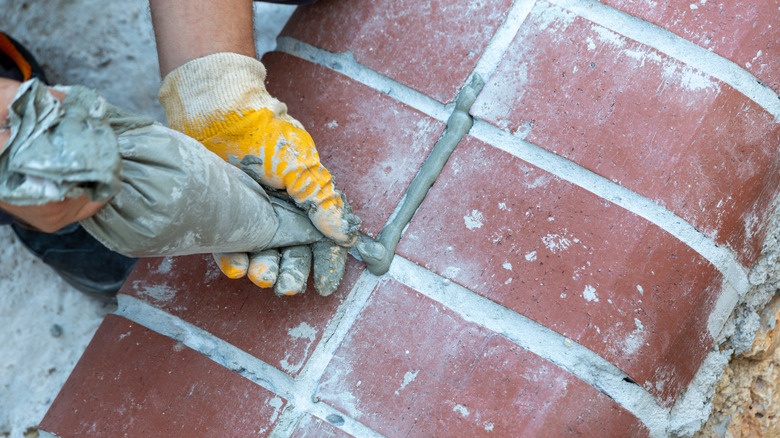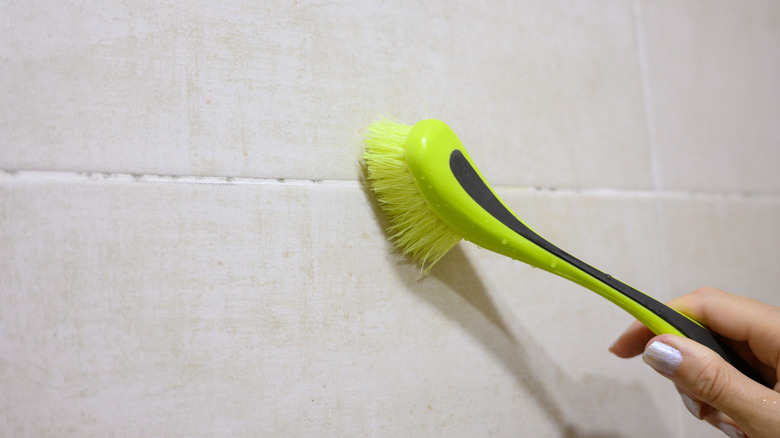Keep Textured Tile Neat And Clean When Touching Up Grout With This Tip
Textured tiles are a beautiful and artistic way to add dimension to any surface. They stimulate a tactile experience, inspiring admirers to reach out and touch the tile themselves to fully take in everything it has to offer. Features of textured tile can include contemporary 3-D waves or even vintage fabric looks that illustrate the look and feel of wallpaper in a luxurious tile format. However, a textured tile's raised surface complicates the process of properly grouting the tile. Especially since grout can get stuck on patterns that are jutting out — thereby making the tile appear dirty. Plus the longer a substance is stuck onto tile, the harder it is to clean.
The best way to keep textured tile looking its best is by touching up grout lines with a small tool like a grout bag — to make sure the grout is applied precisely to the grooves and does not damage the tile's surface. Grout bags are lighter and easier to use than a full trowel or a grout float, plus they give you more control over where the grout is being applied. Trowels and grout floats are typically used to apply grout over a full floor or wall surface that need to be grouted, which is much easier when the tile surface is flat. However, for textured tile, you'll want to make sure that the grouting process doesn't dull the tiles' visual appeal, hence the grout bag.
Grout bags keep textured tiles looking their best
Grout bags resemble a pastry or piping bag that you would find at a bakery for cake decorating or filling treats. The function is the same: fill the wider end with the mixture you're applying, and the mixture will come evenly out of the other end through a small tip that allows for precise application. Grout bags are lightweight as they are typically made of plastic or a stronger vinyl material. If you are using a vinyl grout bag, you should see if it can be cleaned and reused for your next project. Separate metal tips can also added to grout bags to make the application more exact — or if the joints being filled are quite small. Remember that grout bags are not ideal for fast drying grout, so you'll need to be patient when waiting for the grout to harden.
Since a grout bag is a smaller applicator than a grout bucket and float, it requires less grout mixture which can also minimizes mess. The reason you use less grout is because the bag is only used to fill the joints between tiles — which is what ultimately saves the surface of your textured tiles. With that said, the joints need to be filled entirely with grout to assure that the tile will be firmly held in place. Once the grout hardens, use a grout jointer tool to smooth and even out your lines.
Easy fixes for grout and textured tile
If you're looking for tips on how to fix up or clean your tiles, one practice that can be shared among flat and textured tiles is that a simple toothbrush can be used for quick cleanings. However, be sure not to press down too hard as too much pressure could damage the tile or the grout. Also, for smaller touch ups, Martha Stewart suggests using tried and true plastic spoons to fix old grout since they are cheap, easy to find, and the perfect size to fit grout lines. Plus they are small enough to navigate spaces that might need a little extra help, like tricky corners or lines of grout that are super thin.
In a pinch, you can also use a paint project go-to if you are working on a project with minimal grout lines — like if the tile slabs are big enough that not many grout lines were required. Simply cover your tile slab edges with blue painters tape to ensure a clean line. While this strategy works best for projects with fewer grout lines, it can add extra protection to your tile surfaces during application. However, keep in mind that the tape may not be strong enough to stay on if the textured tiles have a pronounced beveled edge.


